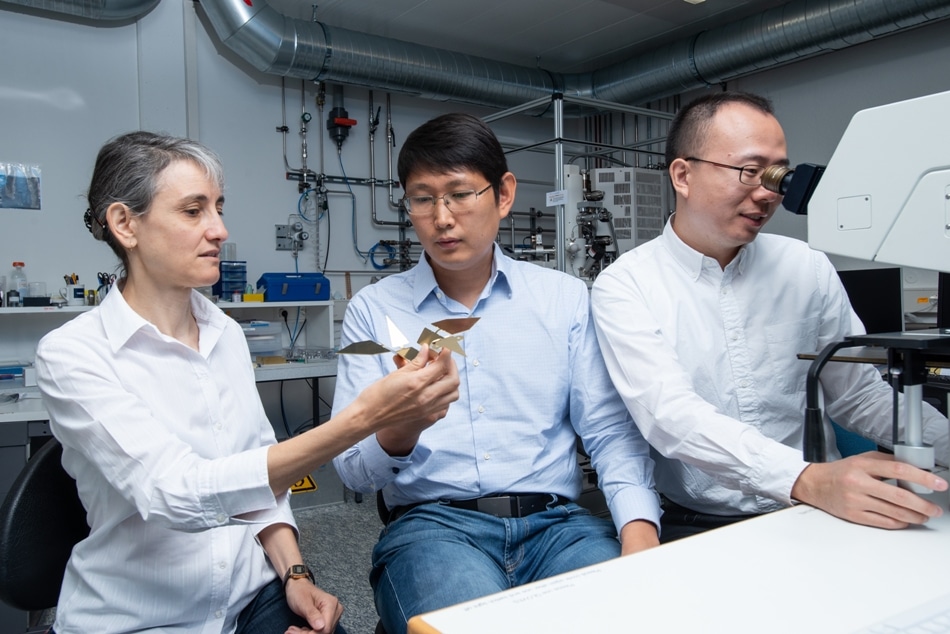Nov 7 2019
At the Paul Scherrer Institute PSI and ETH Zurich, scientists have created an innovative micromachine that is capable of carrying out a variety of actions.
 Laura Heyderman (left) and Tian-Yun Huang (center) look at a model of the origami bird, while Jizhai Cui observes the real microrobot under a microscope. What he can see is shown in the video made by the researchers. Image Credit: Paul Scherrer Institute/Mahir Dzambegovic.
Laura Heyderman (left) and Tian-Yun Huang (center) look at a model of the origami bird, while Jizhai Cui observes the real microrobot under a microscope. What he can see is shown in the video made by the researchers. Image Credit: Paul Scherrer Institute/Mahir Dzambegovic.
The components of the microrobots contain nanomagnets. These tiny magnets are first magnetically programmed and numerous movements are then regulated through magnetic fields. Machines like these measure just a few tens of micrometers and can be used, for instance, in the human body to carry out small operations. The scientists have currently reported their results in Nature scientific journal.
Measuring just a few micrometers across, the robot is similar to a paper bird made with the Japanese art of paper folding called origami. However, the robot is different from a paper structure and moves as if by magic without a perceptible force. It retracts its head and bends its neck or flaps its wings. All these actions are achieved by magnetism.
Researchers from the Paul Scherrer Institute PSI and ETH Zurich were able to organize the micromachine from materials containing tiny nanomagnets. It is possible to program these magnets to assume a specific magnetic orientation. Certain forces act on these programmed nanomagnets when they are subsequently exposed to a magnetic field. When these tiny magnets are placed in flexible components, the forces acting on the magnets make the components move.
Programming the Nanomagnets
The tiny magnets can be repeatedly programmed. This reprogramming leads to different forces, resulting in new movements.
To build the microrobot, the scientists made arrays of cobalt magnets on thin silicon nitride sheets. The bird built from silicon nitride can subsequently perform different movements such as turning, flapping, side-slipping, or hovering.
The movements performed by the microrobot take place within milliseconds. But programming of the nanomagnets only takes a few nanoseconds. This makes it possible to program the different movements one after the other. This means that the tiny microbird can first flap its wings, then slip to the side and afterwards flap again. If needed, the bird could also hover in between.
Laura Heyderman, Head of the Laboratory for Multiscale Materials Experiments, Paul Scherrer Institute
Heyderman is also a professor of Mesoscopic Systems at the Department of Materials, ETH Zurich.
Intelligent Microrobots
This innovative idea represents a major step toward nanorobots and microrobots that store data to give a specific action, and these robots can even be reprogrammed to perform various tasks.
It is conceivable that, in the future, an autonomous micromachine will navigate through human blood vessels and perform biomedical tasks such as killing cancer cells.
Bradley Nelson, Head of Department of Mechanical and Process Engineering, ETH Zurich
“Other application areas are also conceivable, for example, flexible microelectronics or microlenses that change their optical properties,” stated Tianyun Huang, a researcher at the Institute of Robotics and Intelligent Systems at ETH Zurich.
Applications can also be realized where the properties of surfaces change. “For example, they could be used to create surfaces that can either be wetted by water or repel water,” concluded Jizhai Cui, a researcher and engineer at the Mesoscopic Systems Lab.
Video1 crane folding for news
The video shows the movements of the microrobot in the form of a bird that is only a few tens of micrometers across. The drawing at the top left illustrates with different colors that the arrangements of nanomagnets on each component can be magnetized differently. Below is shown how each of the panels is then magnetized differently (red arrows). The video (bottom right) shows that the flapping movement (top right) actually takes place. Video Credit: Paul Scherrer Institute/Swiss Federal Institute of Technology, Zurich.